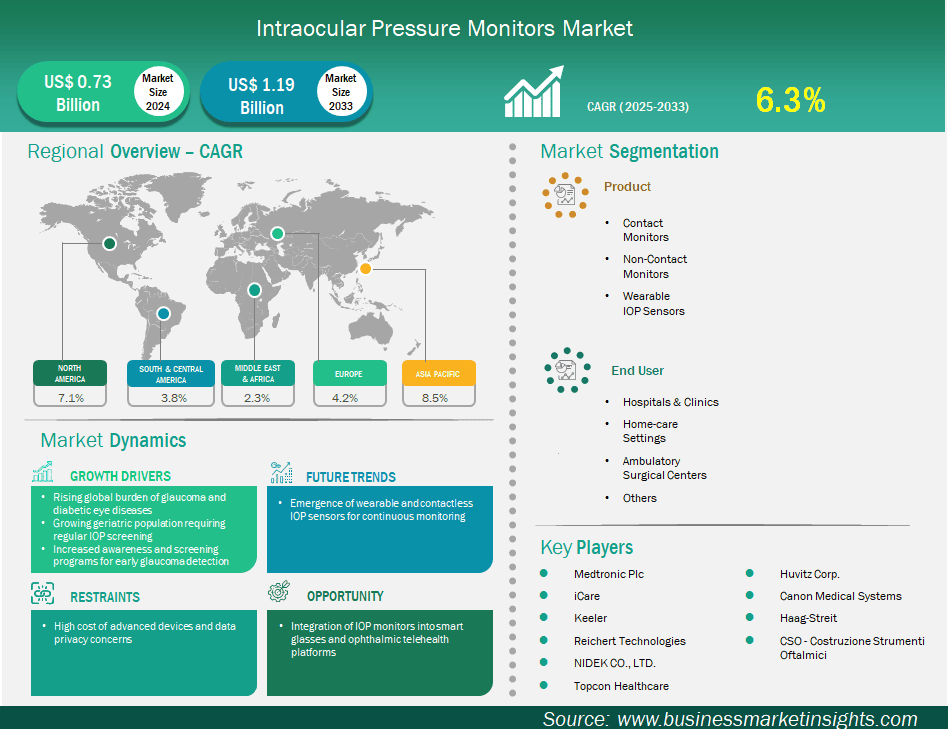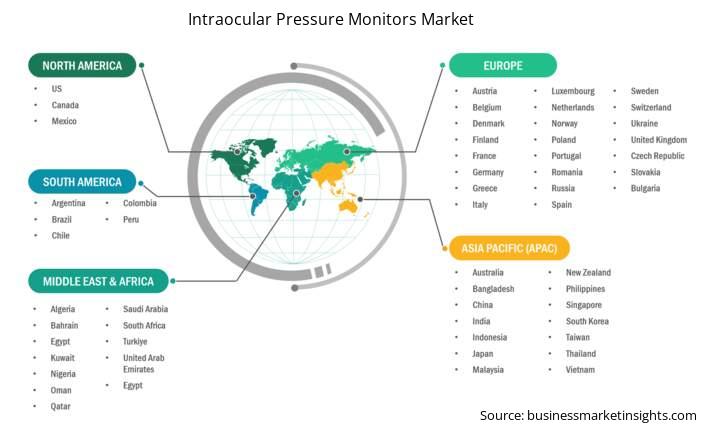Intraocular Pressure Monitors Market Outlook (2022-2033)
No. of Pages: 200 | Report Code: BMIPUB00031766 | Category: Life Sciences
No. of Pages: 200 | Report Code: BMIPUB00031766 | Category: Life Sciences
The intraocular pressure monitors market size is expected to reach US$ 1,198.42 million by 2033 from US$ 733.74 million in 2024. The market is estimated to record a CAGR of 6.3% from 2025 to 2033.
The global intraocular pressure monitors market is experiencing significant growth driven by rising global burden of glaucoma and diabetic eye diseases, growing geriatric population requiring regular IOP screening, increased awareness and screening programs for early glaucoma detection. Intraocular pressure monitors encompass contact monitors, non-contact monitors, wearable IOP sensors. The developing market for intraocular pressure monitoring devices is experiencing growth due to various reasons, including the global growth in prevalence of glaucoma and other eye related diseases, availing individuals of hazard awareness related to eye health and more focus on routine examinations and testing. New technology is improving accuracy, usability and portability of intraocular pressure monitors. There is a market shift toward home-based or continuous monitoring as there is the emergence of new technologies such as sensor-integrated contact lenses and handheld tonometers allowing patients to self-administer the monitor. Self-monitored intraocular pressure devices provide a patient engaged element. Patients can now also analyse their own diurnal intraocular pressure trends and provide remote patients monitoring without being face-to-face with a healthcare professional. This type of information is useful for chronic care patients with diseases such as glaucoma.

Key segments that contributed to the derivation of the Intraocular Pressure Monitors market analysis are product, application, and end user.
Rising Global Burden of Glaucoma and Diabetic Eye Diseases Driving Intraocular Pressure Monitors Market
The increase in the global burden of glaucoma and diabetic eye diseases is a major impetus for the intraocular pressure (IOP) monitors market. Glaucoma is one of the leading causes of irreversible blindness, characterized by progressively debilitating optic nerve damage often related to increased IOP. There were an estimated 76 million people living with glaucoma globally in 2020, that is projected to increase to 111 million by 2040, so the magnitude of this condition will require both prevalent and precise measures of IOP for early identification and effective treatment. Secondly, diabetic eye diseases, prominently diabetic retinopathy, are common causes of vision loss among people with diabetes. In addition, diabetes is increasingly recognized as a significant risk factor for developing glaucoma, suggesting that individuals with diabetes often experience higher mean IOP and have significantly increased risk of developing open-angle glaucoma. This reinforces the connections between glaucoma and diabetic eye diseases and the urgent need for regular screening of IOP in diabetic populations.
Integration of IOP Monitors into Smart Glasses and Ophthalmic Telehealth Platforms
The combination of IOP monitors with smart glasses and telehealth platforms for eye care centers represents a huge opportunity for the IOP monitors market. The combination of remote care and wearable technology provides a solution to many unmet needs in glaucoma care. Smart glasses that have small IOP sensors offer the potential for patients and providers to monitor IOP continuously and in real time throughout the day (and even at night, when IOP may be highest), and without the episodic variability associated with office measurements completed during business hours. Continuous data offers a much more thorough and comprehensive description of an individual patient's IOP history and experience, facilitating individualized management. In particular, even small modifications in treatment regimens that slow down, halt, or reverse the progression of glaucoma can have a direct impact on maintaining vision.
The implementation of eyeglasses with IOP monitoring technology into telehealth platforms would also completely transform the standard of care for eye care providers, particularly in rural and underserved areas of the country. Telehealth can be used to allow for patients to conduct self-measurements from home, and then subsequently, monitor the data that is automatically shared with the patient's ophthalmologist for review at a later time, hopefully eliminating the burden of frequent clinic appointments. Smart glasses with IOP only improves convenience for patients and adherence to monitoring regimens, they ideally also increase accessibility to glaucoma healthcare and improve access to specialized care by enhancing telemedicine capabilities. The COVID-19 pandemic has prompted relatively quick acceptance of telemedicine and increased comfort with digital health solutions, and telemedicine has changed everything from follow-up to initial consultations for those with access to smart glasses, eye care professionals, and/or specialized care.
The intraocular pressure monitors market is classified according to products into contact monitors, non-contact monitors, wearable IOP sensors. The contact monitors segment led the market in 2024 and beyond. Contact tonometers, particularly applanation tonometers such as the Goldmann Applanation Tonometer, have the largest segment in the intraocular pressure monitoring market as they are the gold standard for clinical accuracy and reliability. The GAT, despite being an invasive procedure that requires topical anesthetic and fluorescein dye, has remained the most trusted instrument for ophthalmologists when measuring the force required to flatten an area of the cornea. With decades of practical use, and countless articles validating its use for glaucoma diagnosis and management, the GAT has occupied a rarefied space in modern-day eye care. While non-contact (air puff) tonometers and rebound tonometers have their own benefits, particularly patient comfort and ease of use, many of them are used for screening, and suspicious readings will usually be checked with a contact applanation tonometer. Additionally, multiple applanation tonometers are integrated with slit lamp microscopes which allow them to seamlessly be used in routine examinations. Due to these factors, applanation tonometers are likely to continue to dominate in the professional tonometry landscape.
By end user, the market is segmented into hospitals and clinics, home-care Settings, ambulatory surgical centers, others. The hospitals and clinics segment held the largest share of the market in 2024. These are the end points of care for persons suspected or diagnosed with glaucoma, a condition which requires accurate IOP measurement in order to effectively treat and monitor. Hospitals and clinics are also the first point of care for emergency eye cases, pre-surgical assessment, or post-surgical follow-up, all of which frequently use tonometry. In addition, hospitals and clinics also have the infrastructure, expertise in ophthalmology, and personnel to operate and maintain precision desktop tonometers including Goldmann applanation tonometers. The engagement of hospitals and clinics in glaucoma screening programs and the growing number of patients being referred to eye specialists further establish hospitals and clinics as the primary consumers of IOP monitoring devices.
Intraocular Pressure Monitors Market Report Highlights
Report Attribute
Details
Market size in 2024
US$ 733.74 Million
Market Size by 2033
US$ 1,198.42 Million
Global CAGR (2025 - 2033) 6.3%
Historical Data
2022-2023
Forecast period
2025-2033
Segments Covered
By Product
By End User
Regions and Countries Covered
North America
Europe
Asia-Pacific
South, Central America
Middle East, Africa
Market leaders and key company profiles
The "Intraocular Pressure Monitors Market Size and Forecast (2021–2031)" report provides a detailed analysis of the market covering below areas:

The geographical scope of the intraocular pressure monitors market report is divided into five regions: North America, Asia Pacific, Europe, Middle East & Africa, and South & Central America. The Intraocular Pressure Monitors market in Asia Pacific is expected to grow significantly during the forecast period.
Asia Pacific intraocular pressure monitors market includes China, Japan, India, South Korea, Australia, Bangladesh, New Zealand, Philippines, Singapore, Indonesia, Taiwan, Malaysia, Vietnam, and the rest of Asia Pacific. The increasing incidence of glaucoma, the leading cause of irreversible blindness, is a key contributor, with an immense share of the world's cases concentrated in the region. The aging populations of the Asia Pacific are also contributing to this burden, as the older demographic is more at risk of eye health conditions, such as glaucoma. Increased public awareness and knowledge of eye health, improved healthcare infrastructure, and increased disposable income have led to greater demand for products that support all stages of eye care, including screening and monitoring. The increasing availability of advanced technologies; products that are portable, and/or compatible with smart devices, and government initiatives to improve access to eye care, have also both fuelled, and continued to fuel market growth.
There are some, particular countries leading growth in this space in Asia Pacific. China is a colossal market where population size is contributing to growth, and with approximately an estimated 85 million glaucoma patients in 2022, and its increasing focus in health awareness. With increased government support and technological advancements taking hold in China, demand for diagnostic tonometers is increasing too. In India, a substantial growing market primarily in ophthalmology devices is occurring primarily due to increased disposable incomes, a large proportion of the population with eye diseases and disorders, and higher levels of awareness in eye care, while demand is increasing for eye care due to a focus on preventative care and removal of payment barriers (i.e., access, affordability).
The intraocular pressure monitors market is evaluated by gathering qualitative and quantitative data post primary and secondary research, which includes important corporate publications, association data, and databases. A few of the key developments in the Intraocular Pressure Monitors market are:
The Intraocular Pressure Monitors Market is valued at US$ 733.74 Million in 2024, it is projected to reach US$ 1,198.42 Million by 2033.
As per our report Intraocular Pressure Monitors Market, the market size is valued at US$ 733.74 Million in 2024, projecting it to reach US$ 1,198.42 Million by 2033. This translates to a CAGR of approximately 6.3% during the forecast period.
The Intraocular Pressure Monitors Market report typically cover these key segments-
The historic period, base year, and forecast period can vary slightly depending on the specific market research report. However, for the Intraocular Pressure Monitors Market report:
The Intraocular Pressure Monitors Market is populated by several key players, each contributing to its growth and innovation. Some of the major players include:
The Intraocular Pressure Monitors Market report is valuable for diverse stakeholders, including:
Essentially, anyone involved in or considering involvement in the Intraocular Pressure Monitors Market value chain can benefit from the information contained in a comprehensive market report.